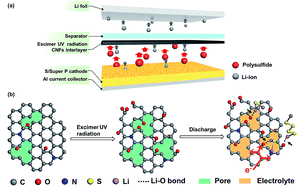Highly efficient and green fabrication of a modified C nanofiber interlayer for high-performance Li–S batteries†
Abstract
Rechargeable Li–S batteries hold great promise for energy storage applications because they exhibit high theoretical capacity, low cost, and non-toxicity. However, the practical applications of these batteries are hindered by their low electronic conductivity and short cycling lifetime. Herein, we present a simple and efficient strategy for improving the performance of Li–S batteries, utilizing excimer ultraviolet radiation to produce a functional C nanofiber (EUV-CNF) interlayer. In the presence of water and oxygen, the above irradiation results in the formation of oxygenated functional groups (e.g., OH and C![[double bond, length as m-dash]](https://www.rsc.org/images/entities/char_e001.gif) O) and nanopores on the interlayer surface. Compared to the sulfur cathode with a pristine C nanofiber (CNF) interlayer, that with the EUV-CNF interlayer exhibits a higher capacity of 917 mA h g−1 after 200 cycles at 0.2C and a lower average capacity fading per cycle (0.16%). This excellent cycling performance is attributed to the functionalization of the CNF interlayer, which not only improves cathode conductivity but also allows effective trapping of polysulfides within the cathode without hampering Li-ion conductivity. Thus, this work presents a simple, efficient, and environmentally friendly approach to improving the performance of Li–S batteries and thus paves the way to expanding their application scope.
O) and nanopores on the interlayer surface. Compared to the sulfur cathode with a pristine C nanofiber (CNF) interlayer, that with the EUV-CNF interlayer exhibits a higher capacity of 917 mA h g−1 after 200 cycles at 0.2C and a lower average capacity fading per cycle (0.16%). This excellent cycling performance is attributed to the functionalization of the CNF interlayer, which not only improves cathode conductivity but also allows effective trapping of polysulfides within the cathode without hampering Li-ion conductivity. Thus, this work presents a simple, efficient, and environmentally friendly approach to improving the performance of Li–S batteries and thus paves the way to expanding their application scope.



 Please wait while we load your content...
Please wait while we load your content...